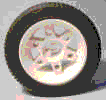|
 previous / next column previous / next column
A PHYSICIST WRITES . . .
(May 2003)
I can remember the exact place on a long straight road in Sussex where (in my previous car) all the digits on the odometer turned at the same time, to show 100,000. It was extraordinary to think that my Nissan Sunny had travelled precisely a hundred thousand miles to get from its showroom to here.
Only later did it occur to me that in order to identify that piece of tarmac correctly the odometer would have had to be accurate to better than one part in a million. At a rough guess, its actual accuracy was probably worse than one in a hundred. This means that the 100,000 miles was quite possibly wrong by more than 500 either way. Forget Sussex — that magic moment could have been any time, any county!
I can think of several reasons for doubting the truth of the odometer and trip-meter when you read off the length of a journey. Won’t the figure be higher if the tyres are worn (front or rear, whichever are driving the car), because of their slightly reduced radius? For similar reasons, won’t the mileage depend on whether the tyre pressures are correct or not, and whether the car is loaded up? And then doesn’t the pressure rise as the tyres warm up on the journey — and as the day warms up?
Let’s start with this last question. You are supposed to check the pressures when the tyres are cold. But how cold is cold? From freezing-point up to 25°C you can expect the pressure to rise by about four pounds (per square inch). There’s not much point, then, in trying to keep exactly to the recommended values!
Hot sun on the tyres will add another pound or two, and so will sustained driving at 70 because of the heat generated in the tyre walls. If the car is fully loaded then the tyres will flex and warm up even more, but will also be more squashed.
Anyway, there’s no doubt that the mileage readings are going to be all over the place, depending on how much of the tyre is flat against the road. I decided to demonstrate this with a simple experiment, measuring the same journey of about four miles twice, changing the pressures by four pounds in between.
The two readings differed by no more than one-fortieth of a mile! In other words, an odometer is consistent to rather better than one part in a hundred, when there are moderate changes in tyre pressure. This was quite a surprise but, on thinking about it, the reason must be that even though the apparent radius of the tyre may vary a bit, its circumference stays constant as it measures out the road.
Back now to the first question: what is the effect on the odometer as the tread wears down — from 8 mm to 2 mm depth, say? This will certainly reduce the circumference of the tyre, by at least 2%, so you can expect your measured journey mileages to increase by this much over the life of the tyres.
The question I can’t answer is how accurate your odometer is now. For that you will need a ruler and a large-scale map to get the distance right, and a long straight road. There’s one of these in Sussex.
Peter Soul
previous / next column
|